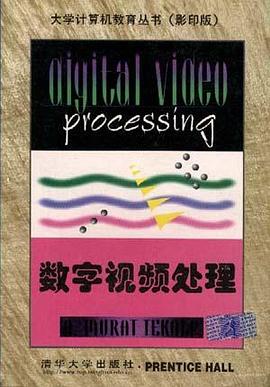数字视频处理

内容简介:
内容简介 数字视频是用数字手段提供全运动视频图象的高新技术,近十 余年来推助了多媒体,虚拟现实,视频通信,VCD等产业的飞速发 展;在即将来临的信息社会中,还将给计算机,通信,影象等产业 以巨大的推动。为帮助读者在未来破浪前进,这本及时问世的书首 次全面讲述了数字视频处理的原理以及面向各种应用的主要算法。 全书分为6个部分:数字视频表示,包括视频图象模型和空域一时 域采样;二维运动估计;三维运动估计;视频滤波;静图象压缩; 视频压缩。本书是在为研究主和高年级学生讲课星础上写成的,取 材全面系统,表述精练,插图丰富并有详尽的文献索引,对于所用 的数学原理,作者进行了仔细处理和精心安排,特别便于自学。
目录:
Contents Preface About the Author About the Notation REPRESENTATION OF DIGITAL VIDEO 1 BASICS OF VIDEO 1.1 Analog Video 1.1.1 Analog Video Signal 1.1.2 Analog Video Standards 1.1.3 Analog Video Equipment 1.2 Digital Video 1.2.1 Digital Video Signal 1.2.2 Digital Video Standards 1.2.3 Why Digital Video? 1.3 Digital Video Processing 2 TIME-VARYING IMAGE FORMATION MODELS 2.1 Three-Dimensional Motion Models 2.1.1 Rigid Motion in the Cartesian Coordinates 2.1.2 Rigid Motion in the Homogeneous Coordinates 2.1.3 Deformable Motion 2.2 Geometric Image Formation 2.2.1 Perspective Projection 2.2.2 Orthographic Projection 2.3 Photometric Image Formation 2.3.1 Lambertian Reflectance Model 2.3.2 Photometric Effects of 3-D Motion 2.4 Observation Noise 2.5 Exercises 3 SPATIO-TEMPORAL SAMPLING 3.1 Sampling for Analog and Digital Video 3.1.1 Sampling Structures for Analog Video 3.1.2 Sampling Structures for Digital Video 3.2 Two-Dimensional Rectangular Sampling 3.2.1 2-D Fourier Transform Relations 3.2.2 Spectrum of the Sampled Signal 3.3 Two-Dimensional Periodic Sampling 3.3.1 Sampling Geometry 3.3.2 2-D Fourier Transform Relations in Vector Form 3.3.3 Spectrum of the Sampled Signal 3.4 Sampling on 3-D Structures 3.4.1 Sampling on a Lattice 3.4.2 Fourier Transform on a Lattice 3.4.3 Spectrum of Signals Sampled on a Lattice 3.4.4 Other Sampling Structures 3.5 Reconstruction from Samples 3.5.1 Reconstruction from Rectangular Samples 3.5.2 Reconstruction from Samples on a Lattice 3.6 Exercises 4 SAMPLING STRUCTURE CONVERSION 4.1 Sampling Rate Change for l-D Signals 4.1.1 Interpolation of l-D Signals 4.1.2 Decimation of l-D Signals 4.1.3 Sampling Rate Change by a Rational Factor 4.2 Sampling Lattice Conversion 4.3 Exercises 5 TWO-DIMENSIONAL MOTION ESTIMATION OPTICAL FLOW METHODS 5.1 2-D Motion vs. Apparent Motion 5.1.1 2-D Motion 5.1.2 Correspondence and Optical Flow 5.2 2-D Motion Estimation 5.2.1 The Occlusion Problem 5.2.2 The Aperture Problem 5.2.3 Two-Dimensional Motion Field Models 5.3 Methods Using the Optical Flow Equation 5.3.1 The Optical Flow Equation 5.3.2 Second-Order Differential Methods 5.3.3 Block Motion Model 5.3.4 Horn and Schunck Method 5.3.5 Estimation of the Gradients 5.3.6 Adaptive Methods 5.4 Examples 5.5 Exercises 6 BLOCK-BASED METHODS 6.1 Block-Motion Models 6.1.1 Translational Block Motion 6.1.2 Generalized/Deformable Block Motion 6.2 Phase-Correlation Method 6.2.1 The Phase-Correlation Function 6.2.2 Implementation Issues 6.3 Block-Matching Method 6.3.1 Matching Criteria 6.3.2 Search Procedures 6.4 Hierarchical Motion Estimation 6.5 Generalized Block-Motion Estimation 6.5.1 Postprocessing for Improved Motion Compensation 6.5.2 Deformable Block Matching 6.6 Examples 6.7 Exercises 7 PEL-RECURSIVE METHODS 7.1 Displaced Frame Difference 7.2 Gradient-Based Optimization 7.2.1 Steepest-Descent Method 7.2.2 Newton-Raphson Method 7.2.3 Local vs. Global Minima 7.3 Steepest-Descent-Based Algorithms 7.3.1 Netravali-Robbins Algorithm 7.3.2 Walker-Rao Algorithm 7.3.3 Extension to the Block Motion Model 7.4 Wiener-Estimation-Based Algorithms 7.5 Examples 7.6 Exercises 8 BAYESIAN METHODS 8.1 Optimization Methods 8.1.1 Simulated Annealing 8.1.2 Iterated Conditional Modes 8.1.3 Mean Field Annealing 8.1.4 Highest Confidence First 8.2 Basics of MAP Motion Estimation 8.2.1 The Likelihood Model 8.2.2 The Prior Model 8.3 MAP Motion Estimation Algorithms 8.3.1 Formulation with Discontinuity Model, 8.3.2 Estimation with Local Outlier Rejection 8.3.3 Estimation with Region Labeling 8.4 Examples 8.5 Exercises III THREE-DIMENSIONAL MOTION ESTIMATION AND SEGMENTATION 9 METHODS USING POINT CORRESPONDENCES 9.1 Modeling the Projected Displacement Field 9.1.1 Orthographic Displacement Field Model 9.1.2 Perspective Displacement Field Model 9.2 Methods Based on the Orthographic Model 9.2.1 Two-Step Iteration Method from Two Views 9.2.2 An Improved Iterative Method 9.3 Methods Based on the Perspective Model 9.3.1 The Epipolar Constraint and Essential Parameters 9.3.2 Estimation ofthe Essential Pararneters 9.3.3 Decomposition of the E-Matrix 9.3.4 Algorithm 9.4 The Case of 3-D Planar Surfaces 9.4.1 The Pure Parameters 9.4.2 Estimation ofthe Pure Parameters 9.4.3 Estimation ofthe Motion and Structure Parameters 9.5 Examples 9.5.1 Numerical Simulations 9.5.2 Experiments with Two Frames of Miss America 9.6 Exercises 10 OPTICAL FLOW AND DIRECT METHODS 10.1 Modeling the Projected Velocity Field 10.1.1 Orthographic Velocity Field Model 10.1.2 Perspective Velocity Field Model 10.1.3 Perspective Velocity vs. Displacement Models 10.2 Focus of Expansion 10.3 Algebraic Methods Using Optical Flow 10.3.1 Uniqueness of the Solution 10.3.2 Affine Flow 10.3.3 Quadratic Flow 10.3.4 Arbitrary Flow 10.4 Optimization Methods Using Optical Flow 10.5 Direct Methods 10.5.1 Extension ofOptical Flow-Based Methods 10.5.2 Tsai-Huang Method 10.6 Examples 10.6.1 Numerical Simulations 10.6.2 Experiments with Two Frames of Miss America 10.7 Exercises 11 MOTION SEGMENTATION 11.1 Direct Methods 11.1.1 Thresholding for Change Detection 11.1.2 An Algorithm Using Mapping Parameters 11.1.3 Estimation of Model Parameters 11.2 Optical Flow Segmentation 11.2.1 Modified Hough Transform Method 11.2.2 Segmentation for Layered Video Representation . 11.2.3 Bayesian Segmentation 11.3 Simultaneous Estimation and Segmentation 11.3.1 Motion Field Model 11.3.2 Problem Formulation 11.3.3 The Algorithm 11.3.4 Relationship to Other Algorithms 11.4 Examples 11.5 Exercises 12 STEREO AND MOTION TRACKING 12.1 Motion and Structure from Stereo 12.1.1 Still-Frame Stereo Imaging 12.1.2 3-D Feature Matching fbr Motion Estimation 12.1.3 Stereo-Motion Fusion 12.1.4 Extension to Multiple Motion 12.2 Motion Tracking 12.2.1 Basic Principles 12.2.2 2-D Motion Tracking 12.2.3 3-D Rigid Motion Ttacking 12.3 Examples 12.4 Exercises 13 MOTION COMPENSATED FILTERING 13.1 Spatio-Temporal Fourier Spectrum 13.1.1 Global Motion with Constant Velocity 13.1.2 Global Motion with Acceleration 13.2 Sub-Nyquist Spatio-Temporal Sampling 13.2.1 Sampling in the Temporal Direction Only 13.2.2 Sampling on a Spatio-Temporal Lattice 13.2.3 Critical Velocities 13.3 Filtering Along Motion TRajectories 13.3.1 Arbitrary Motion Trajectories 13.3.2 Global Motion with Constant Velocity 13.3.3 Accelerated Motion 13.4 Applications 13.4.1 Motion-Compensated Noise Filtering 13.4.2 Motion-Compensated Reconstruction Filtering 13.5 Exercises 14 NOISE FILTERING 14.1 Intraframe Filtering 14.1.1 LMMSE Filtering 14.1.2 Adaptive (Local) LMMSE Filtering 14.1.3 Directional Filtering 14.1.4 Median and Weighted Median Filtering 14.2 Motion-Adaptive Filtering 14.2.1 Direct Filtering 14.2.2 Motion-Detection Based Filtering 14.3 Motion-Compenaated Filtering 14.3.1 Spatio-Temporal Adaptive LMMSE Filtering 14.3.2 Adaptive Weighted Averaging Filter 14.4 Examples 14.5 Exercises 15 RESTORATION 15.1 Modeling 15.1.1 Shift-Invariant Spatial Blurring 15.1.2 Shift-Varying Spatial Blurring 15.2 Intraframe Shift-Invariant Restoration 15.2.1 Pseudo Inverse Filtering 15.2.2 Constrained Least Squares and Wiener Filtering 15.3 Intraframe Shift-Varying Restoration 15.3.1 Overview ofthe POCS Method 15.3.2 Restoration Using POCS 15.4 Multiframe Restoration 15.4.1 Cross-Correlated Multiframe Filter 15.4.2 Motion-Compensated Multiframe Filter 15.5 Examples 15.6 Exercises 16 STANDARDS CONVERSION 16.1 Down-Conversion 16.1.1 Down-Conversion with Anti-Alias Filtering 16.1.2 Down-Conversion without Anti-Alias Filtering 16.2 Practical Up-Conversion Methods 16.2.1 Intraframe Filtering 16.2.2 Motion-Adaptive Filtering 16.3 Motion-Compensated Up-Conversion 16.3.1 Basic Principles 16.3.2 Global-Motion-Compensated De-interlacing 16.4 Examples 16.5 Exercises 17 SUPERRESOLUTION 17.1 Modeling 17.1.1 Continuous-Discrete Model 17.1.2 Discrete-Discrete Model 17.1.3 Problem Interrelations 17.2 Interpolation-Restoration Methods 17.2.1 Intraframe Methods 17.2.2 Multiframe Methods 17.3 A Frequency Domain Method 17.4 A Unifying POCS Method 17.5 Examples 17.6 Exercises V STILL IMAGE COMPRESSION 18 LOSSLESS COMPRESSION 18.1 Basics of Image Compression 18.1.1 Elements of an Image Compression System 18.1.2 Information Theoretic Concepts 18.2 Symbol Coding 18.2.1 Fixed-Length Coding 18.2.2 Huffman Coding 18.2.3 Arithmetic Coding 18.3 Lossless Compression Methods 18.3.1 Lossless Predictive Coding 18.3.2 Run-Length Coding of Bit-Planes 18.3.3 Ziv-Lempel Coding 18.4 Exercises 19 DPCM AND TRANSFORM CODING 19.1 Quantization 19.1.1 Nonuniform Quantization 19.1.2 Uniform Quantization 19.2 Differential Pulse Code Modulation 19.2.1 Optimal Prediction 19.2.2 Quantization of the Prediction Error 19.2.3 Adaptive Quantization 19.2.4 Delta Modulation 19.3 Transform Coding 19.3.1 Discrete Cosine Transform 19.3.2 Quantization/Bit Allocation 19.3.3 Coding 19.3.4 Blocking Artifacts in Transform Coding 19.4 Exercises 20 STILL IMAGE COMPRESSION STANDARDS 20.1 Bilevel Image Compression Standards 20.1.1 One-Dimensional RLC 20.1.2 Two-Dimensional RLC 20.1.3 The JBIG Standard 20.2 The JPEG Standard 20.2.1 Baseline Algorithm 20.2.2 JPEG Progressive 20.2.3 JPEG Lossless 20.2.4 JPEG Hierarchical 20.2.5 ImplementationsofJPEG 20.3 Exercises 21 VECTOR QUANTIZATION, SUBBAND CODING AND OTHER METHODS 21.1 Vector Quantization 21.1.1 Structure of a Vector Quantizer 21.1.2 VQ Codebook Design 21.1.3 Practical VQ Implementations 21.2 Fractal Compression 21.3 Subband Coding 21.3.1 Subband Decomposition 21.3.2 Coding of the Subbands 21.3.3 Relationship to Transform Coding 21.3.4 Relationship to Wavelet Transform Coding 21.4 Second-Generation Coding Methods 21.5 Exercises VI VIDEO COMPRESSION 22 INTERFRAME COMPRESSION METHODS 22.1 Three-Dimensional Waveform Coding 22.1.1 3-D Transform Coding 22.1.2 3-D Subband Coding 22.2 Motion-Compensated Waveform Coding 22.2.1 MC Transform Coding 22.2.2 MC Vector Quantization 22.2.3 MC Subband Coding 22.3 Model-Based Coding 22.3.1 Object-Based Coding 22.3.2 Knowledge-Based and Semantic Coding 22.4 Exerclses 23 VIDEO COMPRESSION STANDARDS 23.1 The H.261 Standard 23.1.1 Input Image Formats 23.1.2 Video Multiplex 23.1.3 Video Compression Algorithm 23.2 The MPEG-l Standard 23.2.1 Features 23.2.2 Input Video Format 23.2.3 Data Structure and Compression Modes 23.2.4 Intraframe Compression Mode 23.2.5 Interframe Compression Modes 23.2.6 MPEG-l Encoder and Decoder 23.3 The MPEG-2 Standard 23.3.1 MPEG-2 Macroblocks 23.3.2 Coding Interlaced Video 23.3.3 Scalable Extensions 23.3.4 Other Improvements 23.3.5 Overview of Profiles and Levels 23.4 Software and Hardware Implementations 24 MODEL-BASED CODING 24.1 General Object-Based Methods 24.1.1 2-D/3-D Rigid Objects with 3-DMotion 24.1.2 2-D Flexible Objects with 2-D Motion 24.1.3 Affine Transformations with TRiangular Meshes 24.2 Knowledge-Based and Semantic Methods 24.2.1 General Principles 24.2.2 MBASIC Algorithm 24.2.3 Estimation Using a Flexible Wireframe Model 24.3 Examples 25 DIGITAL VIDEO SYSTEMS 25.1 Videoconferencing 25.2 Interactive Video and Multimedia 25.3 Digital Television 25.3.1 Oigital Studio Standards 25.3.2 Hybrid Advanced TV Systems 25.3.3 All-Oigital TV 25.4 Low-Bitrate Video and Videophone 25.4.1 The ITU Recommendation H.263 25.4.2 The ISO MPEG-4 Requirements APPENDICES A MARKOV AND GIBBS RANDOM FIELDS A.l Definitions A.l.l Markov Random Fields A.1.2 Gibbs Random Fields A.2 Equivalence of MRF and GRF A.3Local Conditional Probabilities B BASICS OF SEGMENTATION B.l Thresholding B.I.l Finding the Optimum Threshold(s) B.2 Clustering B.3 Bayesian Methods B.3.1 The MAP Method B.3.2 The Adaptive MAP Method B.3.3 Vector Field Segmentation C KALMAN FILTEMNG C.l Linear State-Space Model C.2 Extended Kalman Filtering




评论